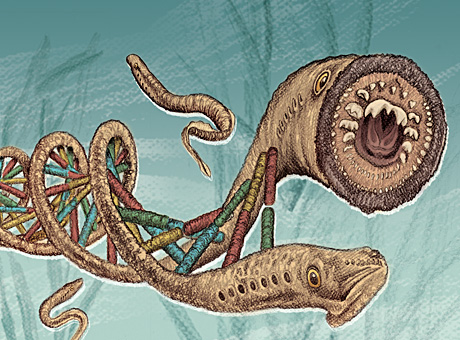
Mapping a living relic
Ancient sea lamprey offers insight into origin of vertebrates

What can we learn about human evolution from an eel-like creature with a sucker-shaped mouth? Apparently, quite a lot.
A large team of scientists has decoded the genome of a sea lamprey — one of the few ancient, jawless species of vertebrates that has survived through the modern era.
The findings were detailed Feb. 24 in Nature Genetics.
Lampreys diverged from our own lineage about 500 million years ago, during the Cambrian period. The new research sheds light on how the species — long considered an invasive predator — adapted and thrived over the ages. Analyzing its genome will provide scientists with insights into the evolution of organisms as diverse as frogs, chickens and humans, all of which have backbones.
“The lamprey genome is unique in that it has characteristics of vertebrates but it also carries evidence of earlier lineages,” says study co-author Wesley C. Warren, PhD, research associate professor of genetics at the The Genome Institute at Washington University. “Decoding this genome is providing us with unique insight into the origin and evolution of all vertebrates.”
Decoding the lamprey genome is providing scientists with unique insight into the origin and evolution of all vertebrates.
Based on fossil records, the Cambrian period is noted as a time when living organisms exploded from single-celled structures to complex, multicelled life forms. During this era, many species developed jaws and a skeletal frame that protected the brain, spine and nervous system. Some, in fact, even developed brains that share some of the same basic structures and functions as the brains of modern humans.
For example, Warren and his colleagues at the University of Kentucky and Michigan State were surprised to discover genes in the lamprey genome that direct the production of myelin, the fatty sheath that insulates nerve fibers and is needed for nerve signals to move from the brain down the spinal cord and into the extremities.
By mapping the sea lamprey genome,scientists hope to uncover more details about how and when humans evolved. Future studies also could pinpoint when people evolved jaws, arms and legs and an adaptive immune system.
Understanding the sea lamprey’s genetic makeup also may lead to ways to limit their destruction of aquatic life. The invasive species feeds by attaching its sucker-shaped mouth to the skin of other fish, including salmon and trout, and burrowing its sharp tongue and teeth into its prey. One sea lamprey can kill more than 40 pounds of fish in its lifetime, and the U.S. and Canadian governments spend $10 million to $15 million annually to control them in the Great Lakes.






